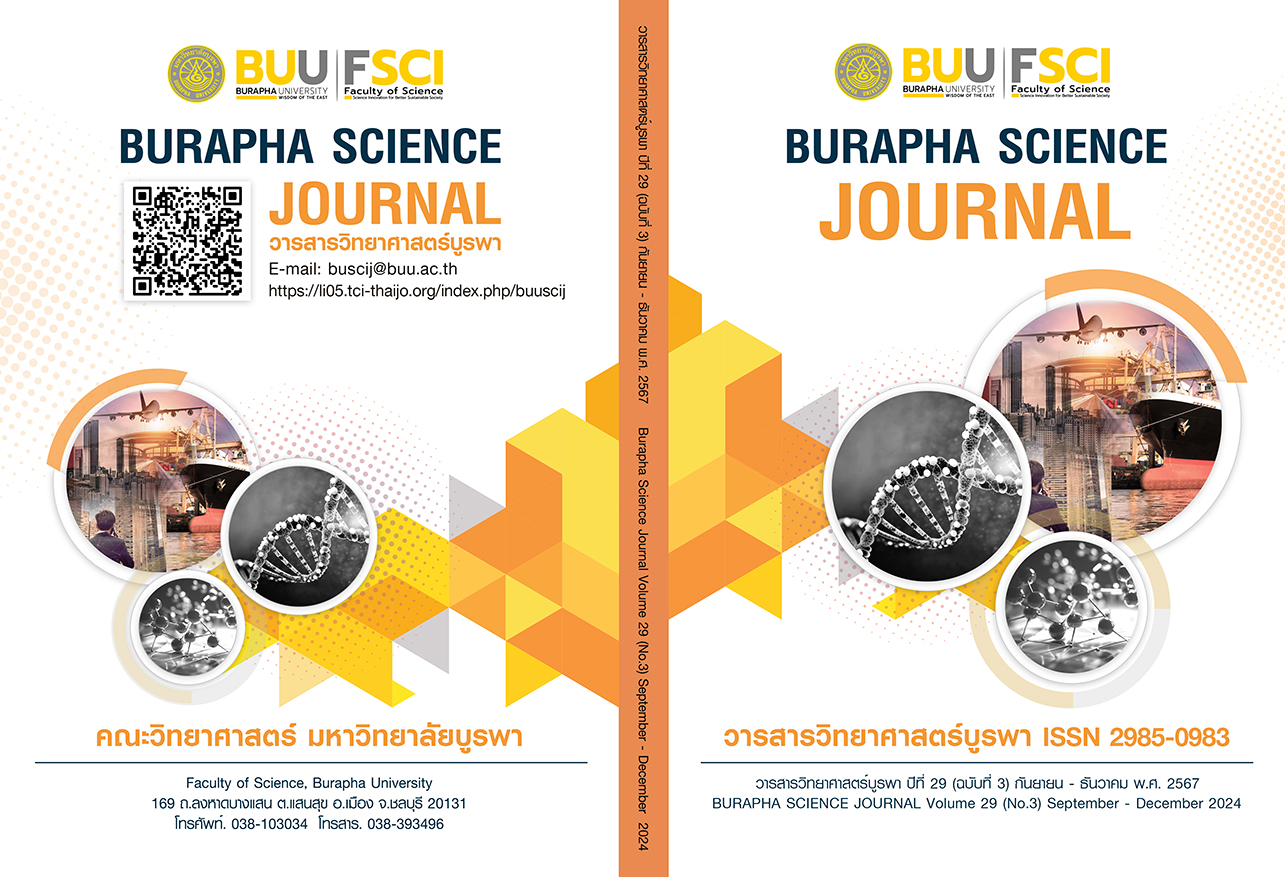การพัฒนาผลิตภัณฑ์คุกกี้ลำดวนผสมข้าวไรซ์เบอร์รี่
คำสำคัญ:
ขนมกลีบลำดวน , คุกกี้, ข้าวไรซ์เบอร์รี่บทคัดย่อ
วัตถุประสงค์และที่มา : ขนมกลีบลำดวนเป็นขนมไทยโบราณที่มีรูปลักษณ์สวยงาม คล้ายกับดอกลำดวน แต่มักพบปัญหาในการผลิตและจำหน่าย อาทิ รูปทรงขนมเกิดการเปลี่ยนแปลงได้ง่ายในระหว่างการขนส่งหรือรอจำหน่าย ผิวด้านนอกขนมมีความชื้น ทำให้ติดที่ตัวบรรจุภัณฑ์ในขณะบรรจุ ส่งผลให้เกิดลักษณะที่ไม่น่ารับประทาน อีกทั้งในกระบวนการผลิตขนมชนิดนี้ต้องอาศัยความประณีต ทำให้ใช้เวลาในการผลิต โดยงานวิจัยนี้มีวัตถุประสงค์เพื่อพัฒนาผลิตภัณฑ์ขนมกลีบลำดวนในรูปแบบของคุกกี้ และศึกษาการใช้ข้าวไรซ์เบอร์รี่ทดแทนการใช้แป้งสาลีในผลิตภัณฑ์คุกกี้ลำดวนเพื่อเพิ่มคุณประโยชน์ในเชิงสุขภาพ ตลอดจนวิเคราะห์คุณค่าทางโภชนาการ คุณภาพทางด้านเคมี กายภาพและจุลินทรีย์ของผลิตภัณฑ์คุกกี้ลำดวนผสมข้าวไรซ์เบอร์รี่
วิธีดำเนินการวิจัย : คัดเลือกสูตรพื้นฐานสำหรับพัฒนาคุกกี้ลำดวน โดยใช้สูตรของขนมกลีบลำดวนที่แตกต่างกัน 4 สูตร จากนั้นนำไปทำการทดสอบทางประสาทสัมผัสทางด้านความชอบกับผู้บริโภคทั่วไปจำนวน 100 คน สูตรพื้นฐานที่ได้รับคะแนนความชอบสูงที่สุดจะถูกนำมาทำการพัฒนาสูตรคุกกี้ลำดวนผสมข้าวไรซ์เบอร์รี่ โดยศึกษาอัตราส่วนที่เหมาะสมของข้าวไรซ์เบอรรี่แทนที่แป้งสาสีในสูตรคุกกี้ลำดวน 6 ระดับ คือ ร้อยละ 0 10 20 30 40 และ 50 ตามลำดับ สูตรที่ได้รับคะแนนความชอบสูงที่สุด จะถูกนำไปพัฒนาและศึกษารูปแบบที่เหมาะสมของผลิตภัณฑ์ และทำการวิเคราะห์คุณค่าทางโภชนาการ คุณภาพทางด้านเคมี กายภาพ และจุลินทรีย์เพื่อประเมินอายุการเก็บรักษา
ผลการวิจัย : ผลการวิจัยพบว่าสูตรพื้นฐานของขนมกลีบลำดวนที่ได้รับคะแนนความชอบสูงที่สุดคือสูตรที่ดัดแปลงจาก Karedee, (2014) ประกอบด้วยแป้งอเนกประสงค์ ร้อยละ 47.62 น้ำตาลไอซิ่ง ร้อยละ 23.81 น้ำมันพืช ร้อยละ 23.81 และ เนยขาว ร้อยละ 4.77 อัตราส่วนที่เหมาะสมในการใช้ข้าวไรซ์เบอรี่แทนแป้งสาลีอเนกประสงค์ คือ ร้อยละ 30 ซึ่งเป็นอัตราส่วนที่ ได้รับคะแนนความชอบโดยรวมสูงสุด (p≤0.05) ในส่วนของการพัฒนาคุกกี้ลำดวนผสมข้าวไรซ์เบอรี่ ใช้วิธีการปรับเนื้อสัมผัสของผลิตภัณฑ์โดยการลดการใช้น้ำมันพืช และเพิ่มส่วนผสมของเนยขาว และขึ้นรูปของผลิตคุกกี้โดยใช้พิมพ์ ตามวิธีการผลิตคุกกี้แบบกด โดยคุณค่าทางโภชนาการของคุกกี้ลำดวนผสมข้าวไรซ์เบอร์รี่ปริมาณ 100 กรัม ให้พลังงานประมาณ 538.23 กิโลแคลอรี่ และจากการศึกษาคุณภาพทางด้านเคมี กายภาพ และจุลินทรีย์ของคุกกี้ลำดวนผสมข้าวไรซ์เบอร์รี่ เป็นระยะเวลา 2 เดือน พบว่าคุณภาพทางด้านแคมี กายภาพมีการเปลี่ยนแปลงเล็กน้อย ในขณะที่คุณภาพทางด้านจุลินทรีย์ยังคงอยู่ในเกณฑ์มาตรฐานผลิตภัณฑ์ชุมชน “คุกกี้” (มผช. 118/2555)
สรุปผลการวิจัย : สูตรพื้นฐานสำหรับการพัฒนาเป็นคุกกี้ลำดวนประกอบด้วย แป้งสาลีสำหรับทำเค้ก ร้อยละ 47.62 น้ำตาลไอซิ่ง ร้อยละ 23.81 น้ำมันพืช ร้อยละ 23.81 และเนยขาว ร้อยละ 4.77 และอัตราส่วนที่เหมาะสมของการใช้ข้าวไรซ์เบอรี่แทนแป้งสาลี คือ ร้อยละ 30 การพัฒนาคุกกี้ลำดวนใช้วิธีการปรับลักษณะของขนมกลีบลำดวนให้มีลักษณะคล้ายคุกกี้ โดยการปรับลดปริมาณน้ำมันพืชและเพิ่มส่วนผสมของเนยขาว ขึ้นรูปขนมอาศัยวิธีการทำคุกกี้ในรูปแบบของคุกกี้กด ทั้งนี้คุกกี้ลำดวน 100 กรัม ให้พลังงานประมาณ 538.23 กิโลแคลอรี่ และคุณภาพทางด้านเคมี กายภาพ และจุลินทรีย์ของคุกกี้ลำดวนในระยะเวลา 2 เดือน ยังอยู่ในเกณฑ์ที่สามารถบริโภคได้
เอกสารอ้างอิง
Arjinajarn, P., Chueakula, N., Pongchaidecha, A., Jaikumkao, K., Chatsudthipong, V., Mahatheeranont, S., Norkaew, O., Chattipakorn, N., & Lungkaphin, A. (2017). Anthocyanin-rich Riceberry rice bran extract attenuates gentamicin-induced hepatotoxicity by reducing oxidative stress, inflammation and apoptosis in rats. Biomedicine & pharmacotherapy, 92, 412-420.
Barbosa, C., Gustavo, V., Schmidt, S. J., & Labuza, T. P. (2007). Water Activity in Foods: Fundamentals and Applications. Ames, Los Angeles: Blackwell.
Boonpienpon, N.,& Wongwiwattana, B. (2021). The Management of Traditional Thai Desserts to Promote Souvenir Business in Phetchaburi. Journal of Public Administration and Politics, 10(2), 62-75.
Fong-in, S., Kadwilard, J., Lainchuea, S., Sanegkham, S., Dokkham, W. , & Phandaeng, P. (2021). Effect of Packaging on Quality Changes of Black Glutinous Rice (Kham Phayao) Cracker during Storage. Burapha Science Journal, 26(1), 33-45. (in Thai)
Gallagher, E., Gormley,T.R., & Arendt, E.K. (2004). Recent advances in the formulations of gluten-free cerealbased products. Trends in Food Science and Technology, 15,143-152.
Given, P. S. 1994. Influence of fat and oil–physicochemical properties on cookie and cracker manufacture. In Faridi, H. (ed). The Science of Cookie and Cracker Production. New York: Chapman and Hall.
Jacob, J., & Leelavathi, K. (2007). Effect of fat-type on cookie dough and cookie quality. Journal of Food Engineering, 79(1), 299-305.
Jirasatid, S. (2021). Effect of Riceberry rice bran on product development of functional drinkable goat milk yogurt. The Journal of King Mongkut's University of Technology North Bangkok, 31(2), 356-366. (in Thai)
Julya, W. (2014). Aspicious thai desserts. Bangkok: Phetpraguy. (in Thai)
Kanthong, H. (2015). Stevia sweet and healthy herb. Food Journal, 45(3), 41-44. (in Thai)
Karedee, K. (2014). Thai Desserts. Bangkok: Maeban. (in Thai)
Kraboun, K., Punumong, P., Rojsuntornkitti, K., Kongbangkerd, T., Tantivititapong, I., Junthong, N., Roipomma, P., & Saimek, M. (2020). Effect of Riceberry rice Rice Flour and Glutinous Rice Flour on Some Qualities of Gluten-Free Cookies. Rajabhat Agriculture Journal, 19 (1), 20-27. (in Thai)
Langkapin, J., Parnsakhorn, S., & Oupathumpanont, O. (2023). Effects of drying temperatures and times on the Beta-carotene content and physical properties of osmosis Mayongchit product. Burapha Science Journal, 28 (3), 2034-2053. (in Thai)
Lateh, P., Sensana, S., Sulong, S., & Posokaboot, S. (2021). Impact of Trans-Fat Consumption and Guideline of Safety Consumption from Trans-Fat. Journal of Health Science of Thailand, 30(Suppl 2), S367-S375. (in Thai)
Leardkamolkarn, V., Thongthep, W., Suttiarporn, P., Kongkachuichai, R., Wongpornchai, S., & Wanavijitr, A. (2011). Chemopreventive properties of the bran extracted from a newly-developed Thai rice: The Riceberry rice. Food chemistry, 125(3), 978-985.
Mamat, H., & Hill, S. E. (2014). Effect of fat types on the structural and textural properties of dough and semi-sweet biscuit. Journal of food science and technology, 51, 1998-2005.
Mungkung, R., Dangsiri, S., Satmalee, P., Surojanametakul, V., Saejew, K., & Gheewala, S. H. (2024). The nutrition-environment nexus assessment of Thai Riceberry rice product for supporting environmental product declaration. Environment, Development and Sustainability, 26(2), 4487-4503. (in Thai)
Nachaisin, M., Teeta, S., Deejing, K., Ponken, T. & Pharanat, W. (2016). Development of Riceberry nutrition instant rice; high in anthocyanin for healthy elderly person. Physics program, Faculty of Science and Technology, Rajabhat Maha Sarakham University. 1-75. (in Thai)
Nagendra, P, M., Sanjay, K., Shravya, K, M., Vismaya, M., & Nanjunda, S, S. (2011). Health benefits of rice bran-a review. Journal of Nutrition & Food Sciences, 1(3), 1-7.
Naiwikun, O., & Chaemmek, C. (2010). Basic baking science and technology. Bangkok: Kasetsart University Press, 224 p. (in Thai)
Nimeplub, S. (2021). Product development of gluten-free Khanom Gleeb-Lamduan (Thai shortbread cookies) from Job's Tears flour. Master’s thesis, Rajamangala University of Technology Phra Nakhon. (in Thai)
Pakdeechanuan. P., & Sahadsatam, A. (2020). Trans Fatty Acids Content in Non-dairy Cream, Margarine and Shortening Products Distributed in Pattani Provinc. Rajamangala University of Technology Srivijaya Research Journal, 13(1). 1-11. (in Thai)
Panyoyai, N., & Suwannalert, P. (2023). Changes in relative humidity on crispness of dried sheet food produced by Thai community. Burapha Science Journal, 28(2), 1324-1340. (in Thai)
Phugan, P., Nuchim, P., Satam, N., & Pransua, A. (2021). Development of cookies with fiber supplementation from pineapple residues of baking by a charcoal stove. Srinakharinwirot University Journal of Sciences and Technology, 13(25), 97-109. (in Thai)
Poolcharoensil, N., Uthai, N., Thawerattanon, N., Yampuang, R., Subanmanee, N. , & Klungvijit, S. (2023). Effect of storage time on chemical, physical and microorganism quality of Kanom Nah Nuan. Journal of Home Economics, 66(1), 120-130. (in Thai)
Prasert, W., & Boonkhun, C. (2023). Utilization of bean puree as a fat replacer in cookies. Journal of Food Research and Product Development, 53(1), 19-37. (in Thai)
Ranok, A., & Kupradit, C. (2020). Effect of whey protein and Riceberry rice flour on quality and antioxidant activity under gastrointestinal transit of gluten-free cookies. AIMS Agriculture and Food, 5(3), 434-448.
Ratanopas, W. (2019). Good eat for good health in the 21st century. The Golden Teak: Science and Technology Journal, 4(1), 1-14. (in Thai)
Rattanapanone, N. (2002). Food chemistry. Bangkok: Odeon Store. 487 p. (in Thai)
Raungrusmee, S., Jadwong, K., & Wongtong, O. (2018). Development of sandwich bread formulation substituted wheat with Riceberry rice bran. Phranakhon Rajabhat Research Journal (Science and Technology), 13(1), 123-138. (in Thai)
Rujirapisit, P., Sangkaeo, W., & Ieowsakulrat, S. (2012). Nutritional value of 9 rice cultivars. Agricultural Science Journal, 43(2), 173-176. (in Thai)
Schopf, M., & Scherf, K. A. (2021). Water absorption capacity determines the functionality of vital gluten related to specific bread volume. Foods, 10(2), 1-13.
Shesot, T., Noeisungnoen, S., Arnun, A., & Phugan, P. (2021). Product development of cookies Singapore from Ricerberry bran flour by using rice bran oli shortening to substitute white butter. Phranakhon Rajabhat Research Journal (Science and Technology), 16(1), 141-154. (in Thai)
Songpranam, P. (2004). Thai foods. Bangkok: SE-ED. (in Thai)
SothornvitI, R. (2007). Introduction to food chemistry and microbiology. Bangkok: Kasetsart University Press. 231 p. (in Thai)
Sukhonthara, S. (2016). Development of germinated Riceberry rice Thai egg custard with reduced sugar. Srinakharinwirot Science Journal, 32 (2), 195-209.
Sukkaseam, K., & Niamsuk, J. (2022). Effect of substitution of wheat flour with Riceberry rice flour on physical and sensory qualities in Tuile cookies. The 9th Nakhonratchasima College Conference 2022, 516-525. (in Thai)
Thonanon, T., & Kongpun, S. (2002). Tamrab Ahan Witthayalai Nai Wang. Bangkok: Saengdaet publisher. (in Thai)
ดาวน์โหลด
เผยแพร่แล้ว
รูปแบบการอ้างอิง
ฉบับ
ประเภทบทความ
สัญญาอนุญาต
ลิขสิทธิ์ (c) 2024 คณะวิทยาศาสตร์ มหาวิทยาลัยบูรพา

อนุญาตภายใต้เงื่อนไข Creative Commons Attribution-NonCommercial-NoDerivatives 4.0 International License.
Burapha Science Journal is licensed under a Creative Commons Attribution-NonCommercial-NoDerivatives 4.0 International (CC BY-NC-ND 4.0) licence, unless otherwise stated. Please read our Policies page for more information




